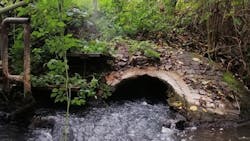Study: Treated wastewater effluent affects invertebrate communities
A comprehensive study examined 170 wastewater treatment plants in Hesse, Germany to see how the plants’ effluent affected species composition, according to a press release from Goethe University Frankfurt.
Wastewater treatment plant effluent can bring both harms and benefits to local fauna. Certain insect orders, such as stonefly and caddisfly larvae, can be decimated — while certain worms and crustacean populations can benefit.
A team from Goethe University Frankfurt led by Daniel Enns and Jonas Jourdan has corroborated this in a comprehensive study, which has now been published in the journal Water Research. They examined 170 wastewater treatment plants in Hesse in relation to species composition.
Wastewater treatment plants’ ability to completely remove what are known as micropollutants from wastewater is mostly limited. These substances include, for example, active ingredients from pharmaceuticals and personal care products, pesticides and other synthetic substances, placing an additional burden on rivers and streams. This exacerbates the challenges faced by already vulnerable insect communities and aquatic fauna.
Previous studies – which have primarily focused on single wastewater treatment plants – have already shown that invertebrate communities downstream of such effluents are generally dominated by pollution-tolerant taxa.
Until now, however, it was unclear how ubiquitous these changes are. That is why a team of biologists from Goethe University Frankfurt has now studied extensively how wastewater from 170 wastewater treatment plants in Hesse has an impact on the species composition of invertebrates.
The researchers were able to identify significant shifts in the composition of the species community between sites located upstream and downstream of wastewater treatment plants. Some species were particularly affected by effluents from wastewater treatment plants – such as stonefly and caddisfly larvae, which disappear entirely in some places. Other taxa, such as certain worms and crustaceans, by contrast, benefit and are found in greater numbers. This change can be observed especially in streams and smaller rivers.
Overall, wastewater treatment plants alter conditions downstream to the advantage of pollution-tolerant taxa and to the disadvantage of sensitive ones.
